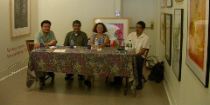 Libby told you about the show in her post below, so I’ll tell you about the two-hour panel discussion Stella and I attended July 31 in Taller Puertorriqueno’s gallery, a wonderful group grope about Chicano culture and identity that had a lot in common with Puerto Rican artists soul-searching for same. (I’m thinking of Adal Maldonado‘s great recent exhibit at Taller and Roxana Perez-Mendez‘s also recent video installation at Temple Gallery in “Mixmaster Universe.” See my posts on Maldonado and Perez-Mendez for more. (top image is the panel)
Libby told you about the show in her post below, so I’ll tell you about the two-hour panel discussion Stella and I attended July 31 in Taller Puertorriqueno’s gallery, a wonderful group grope about Chicano culture and identity that had a lot in common with Puerto Rican artists soul-searching for same. (I’m thinking of Adal Maldonado‘s great recent exhibit at Taller and Roxana Perez-Mendez‘s also recent video installation at Temple Gallery in “Mixmaster Universe.” See my posts on Maldonado and Perez-Mendez for more. (top image is the panel)
I’m going to run a few images here that have a common thread — they depict fighters — boxers, wrestlers, superheroes — imagined or real, all are symbols of embattlement, which is perhaps how Chicano and Latino artists feel about themselves and their communities vis a vis the USA.
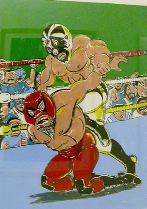
Around a dozen people attended the discussion. That’s a good turnout on what was a sunny Saturday afternoon in late July. (right is Xavier Garza‘s “El Mil Mascaras”)
The four panel members, from left to right above included
–moderator Joseph Gonzalez, a Taller Board member and Temple University grad student working on a Ph.D. in cultural anthropology (focussing on Chicano history);
—Sam Coronado, founder of Coronado Studios, Austin, TX;
—Marta Sanchez, San Antonio-born Philadelphia Chicano artist and activist (founder of the local children’s charity event “Cascarones por la Vida”);
—Gustavo Leclerc, artistic director, Self-Help Graphics (SHG), Los Angeles.
Moderator Gonzalez started things off by pointing out the nice three-way dialog in the gallery — between Southwest, West Coast and East Coast art and artists. Gonzalez said he was interested in this work as a kind of reference for the next generation of Chicano artists. I thought that was an interesting point– children born today may have a different connection to the source material than what today’s artists have. (left below is Teddy Sandoval‘s “Angel Baby”)
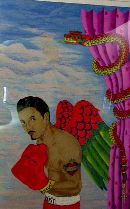
Sanchez spoke about her childhood and about an aunt giving her her first piece of art , a “shopping cart” religious icon that she charished. “It wasn’t just the symbol of Christ, it was the paint …and that someone bought it for me,” she said. Sanchez later carried the idea about the purchase of real art forward saying that printmaking is a great way to put art in people’s hands — it’s affordable, beautiful, and valuable. Sanchez said she would encourage corporations to buy Chicano art as a way of supporting the artists. About the making of art, Sanchez said “We need it [art] to keep the culture going.” (right below is Alfredo de Batuc‘s “Emiliano con Zuecos”)
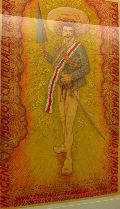
Leclerc of SHG, born in Mexico but living in the U.S. since the 1980s became SHG’s artistic director two months ago when the 30-year old print studio reached out to him in its quest to renew itself and move to another level. He spoke about art as a way of telling the story of Chicanos in America, a story left largely untold by the American media and Hollywood. “Hollywood is good at denying [we’re here],” he said. “We are kind of like ghosts.” (left below is Alma Lopez‘s “Our Lady of Controversy”)
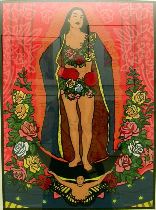
Leclerc explained that his organization is artist-run and that they have a large membership, some 900 artists. When they have a meeting, 50 artists show up and it lasts four hours! “It’s very organic, everyone can go there,” he said about the community organization that also has a gallery space. New issues for SHG are how to keep up the quality of the work and respond to the needs of a broader group. Money and physical space are also issues. (right below is Laura Molina‘s “The Jaguar”)
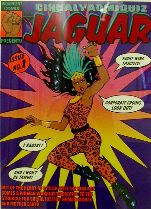
Coronado talked about his beginnings as an artist after serving in the Vietnam war. He said he had no direction for his art until he started seeing Chicano art, like the works of Carmen Lomaz Garza. “That was very inspirational. I found a direction,” he said. In the 1980s, Coronado went to SHG to make a print and afterwards decided to create his own print studio. (left below is Fidencio Duran‘s “High Heel Shoes” which reminds me of Carmen Lopez Garza’s work)
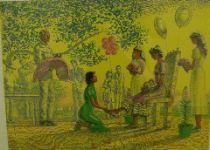
Asked what he felt his role was vis a vis artists, Coronado said it was basically to help get the story out there about Chicano artists.
“Without Taller, SHG and my little studio in Texas, Latino artists…have a hard time exhibiting and letting mainstream America know we’re around. In my region we’re considered folk artists, we’re not considered mainstream artists. Now with the studios, I’ve seen a difference.”
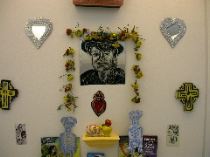
Sanchez agreed.
“Works on paper are more accessible and can reach more people. An artist can donate a work on paper to libraries. A painting is a little more problematic.”
(right is detail from Sanchez‘s shrine to Chicano author Gloria Anzaldu)
Everyone agreed that the challenge to continuing into the future is money. And with grant money dwindling (both studios are non-profits), Coronado indicated “We won’t be able to do away with grants but we’re trying to do more with sales.”
I’ll comb my notes for more but I wanted to get this up quickly. It was a great discussion and it’s a fabulous show.










